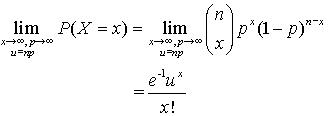

Example 1:
Customer arrivals at a service station following a Poisson process with rate u= 5 customers per hour.
What is the probability that 2 customers arrive in the next hour?
Solution:
u=5 and x=2. So p(2)= [e^(-5)] (5^2)/(2!) = 0.0842
A: What is the probability that no customers arrive in the next hour?
What is the probability that 2 or more customers arrive in the next hour?
Solution:
P(X>=2)= 1- P(X£1)
=1- [P(0)+P(1)]
= 1-[e^(-5)] (5^0)/(0!) + e^(-5)] (5^1)/(1!)]
=1-[ 0.0067+0.0337]
=1-0.0404
=0.9596
B: What is the probability that 3 or more customers arrive in the next hour?

Example 2:
The probability of hitting the bullseye in a dart game is 0.2. Since each throw of the dart is independent of one another, then the number of bullseyes in 50 throws has a binomial distribution with n=50 and p=0.2. We use a Poisson approximation to the binomial with u=np=50(0.2)=10. If X deontes the number of bullseyes then what is P(X>3)?
Solution:
P(X>3)=1-P(X£3)
= 1- [P(0)+P(1)+P(2)+P(3)]
=1- [e^(-10) (10^0) / (0!) + e^(-10) (10^1)/ (1!) + e^(-10) (10^2) / (2!) + e^(-10) (10^2) / (2!) ]
=1-0.0103
=0.9897
What is P(X>=6)? (Use table 3 in the Appendix)